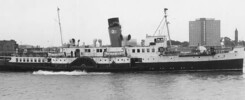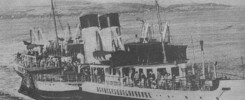Seventy years ago, in the summer of 1935, Londoners had the opportunity to sail down the Thames from Tower Pier every day, excepting Fridays, to Southend, Margate, Ramsgate or Clacton on any one of three huge paddle steamers, the Golden Eagle of 1909, the modern Crested Eagle of 1925 and the almost brand new Royal Eagle freshly off the stocks only three years earlier in 1932.
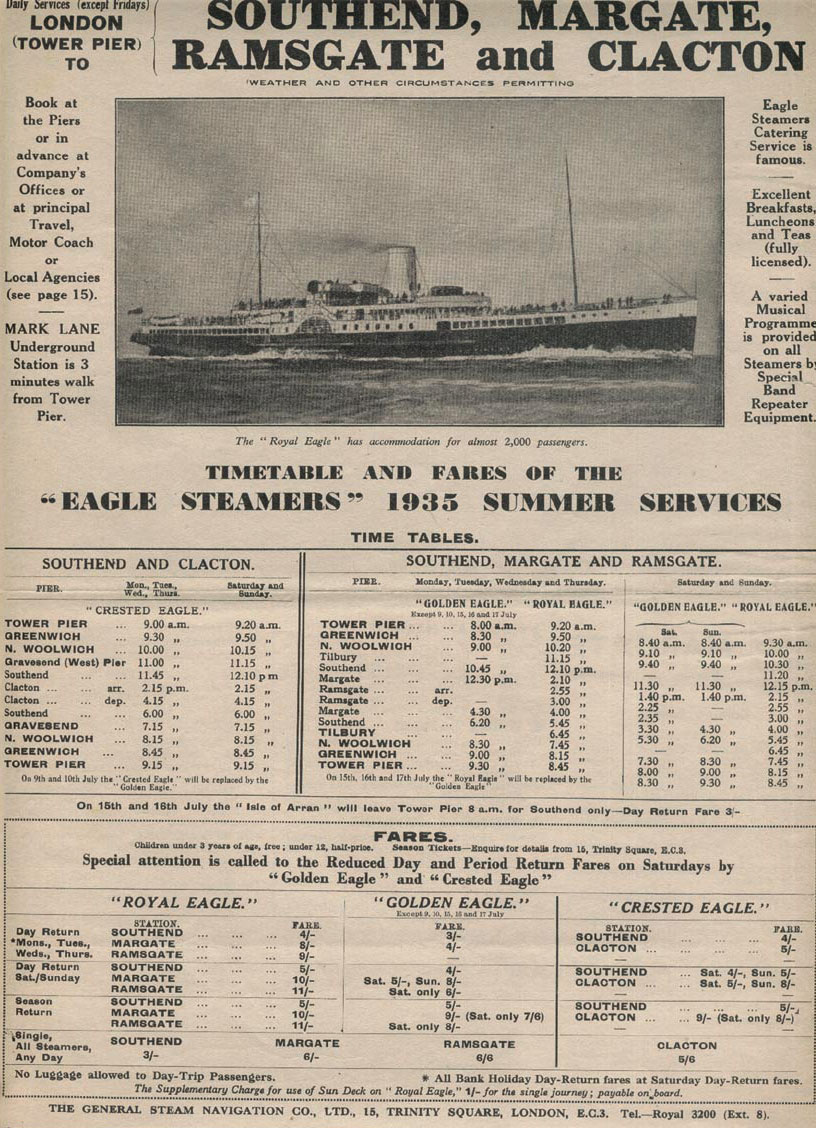
These were very large excursion steamers with a combined capacity of almost 5,000 passengers. With a gross tonnage of 1,539 tons the Royal Eagle was more than twice the size of the Waverley and was five times bigger than Cosens’ Consul. This size gave them a huge ability to take money when the going was good and a huge ability to loose it when it wasn’t.
Each ship was marketed with their own slogan. The Royal Eagle was “London’s Own Luxury Liner”. The Crested Eagle was the “Greyhound of the River” and the Golden Eagle was styled “The Happy Ship”. The Eagle Steamer handbook of 1932 explains:
The slogan we have adopted may cause people to wonder what difference can be made between ships going on afternoon cruises to sea. We lay claim that once you are aboard the “Golden Eagle“, there is not a dull moment. Sports and games start immediately on leaving the pier, the kiddies find real fun and enjoyment in the balloon-blowing competitions, skipping, musical chairs, tug of war and streamer throwing. Even the grown-ups cannot be kept out; they become young once again, and want to blow balloons and enter into the fun with all the keenness of the youngsters. Soon all are one great big happy family; hence our slogan, “The Happy Ship”.
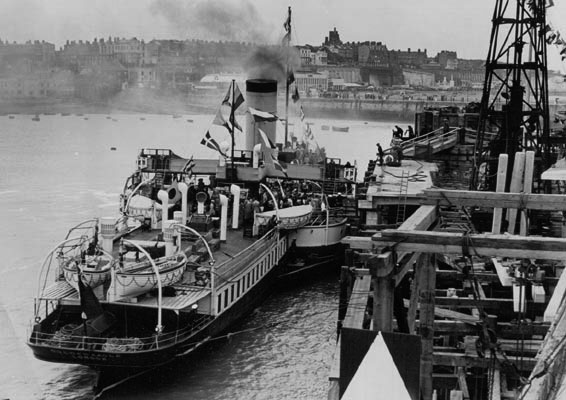
First away each summer day in 1935 was “The Happy Ship” and the oldest of the trio, the Golden Eagle, (pictured above at Ramsgate) setting off from Tower Pier at 8am and calling at Greenwich, North Woolwich and Southend for arrival at Margate at 12.30pm from where she would have run an afternoon cruise. On Saturdays she carried on to Ramsgate.
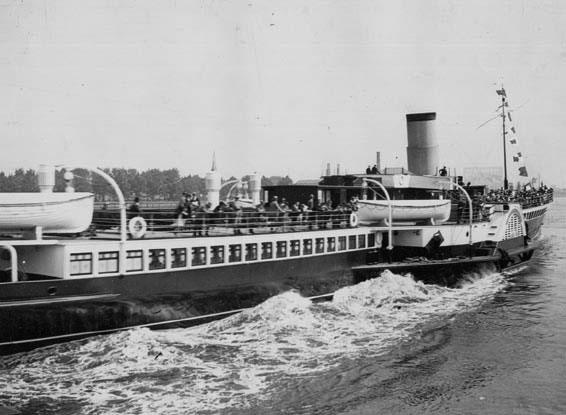
Second away, at 9am, was “The Greyhound of the River”, the Crested Eagle (pictured above) calling at Greenwich, North Woolwich, Gravesend West Pier, Southend and then on to Clacton where she was scheduled to arrive at 2.15pm before undertaking another short cruise.
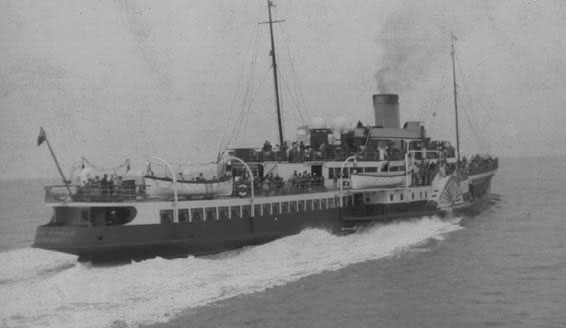
Last away, at 9.20am, was “London’s Own Luxury Liner” the Royal Eagle (pictured above) calling at Greenwich, North Woolwich, Tilbury, Southend and Margate before proceeding on to Ramsgate.
The three were due back in London at 9.15pm. 9.30pm and 8.45pm respectively although exact times could vary considerably if the tide was against them both ways, if the loadings were high meaning longer alongside each pier and, occasionally, if caught by very low tides on what was wittily called “The Overland Passage” because of its very shallow depths off the North Kent Coast off the Isle of Sheppey. Timings were a little, but not much, later on Saturdays and Sundays.
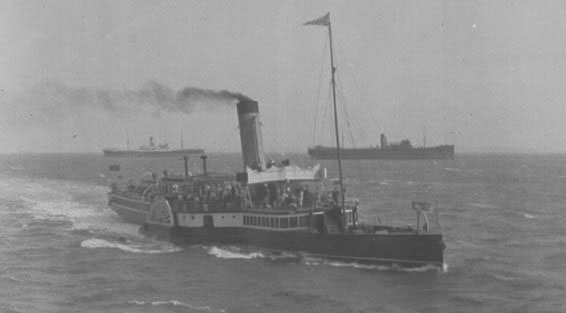
The veteran former Clyde steamer Isle of Arran (pictured above off Southend) of 1892 also gets a mention. She was bought by the General Steam Navigation Co. in 1933 and ran for four years for the company operating their PLA dock cruises and shorter excursions. Here, in 1935, she has been scheduled on the 15th and 16th July to take the 8am sailing from Tower Pier as far as Southend whilst the Golden Eagle fills in for the Royal Eagle on the 9.20am trip with the latter away at King George V’s Silver Jubilee Naval Review at Spithead. Although the Golden Eagle is rostered to stand in for the Crested Eagle on 9th and 10th July, there is no mention of any replacement for the Clacton sailings during the Naval Review. Presumably these were cancelled as the Crested Eagle also sailed round to Southampton for the event.
The leaflet also shows that the transport economics fare structure policy of the likes of Ryanair and easyJet today was already in existence on the Thames steamers in the 1930s. For example, it would have cost you 10/- (or 12/- if you had chosen to sit on the exclusive sun deck both ways) to sail from London to Margate and back on “London’s Own Luxury Liner”, the Royal Eagle, on a Saturday or a Sunday, quite a lot of money at the time. But you could have done the same trip on the same ship for only 8/- during the week. Or if you had chosen to slum it aboard the “Happy Ship”, the Golden Eagle, and take advantage of all the balloon blowing and skipping, etc, you would have got the same return trip to Margate for a mere 4/- during the week but you would have had to stump up 5/- for it on a Saturday and dig even deeper into your pocket on a Sunday, as the fare rocketed up to 8/-, the same price as the toffs were paying for “London’s Own Luxury Liner” during the week. With a keen commercial acumen, the company set the prices according to the level of demand for any cruise and the size of the pockets of the different market segments which they were targeting.
Despite her modernity, “London’s Own Luxury Liner”, the Royal Eagle was out of date almost before she got going. This same season, 1935, saw a consortium led by the New Medway Steam Packet Co’s Capt Shippick introduce the Queen of the Channel, the first of the huge Diesel propeller driven excursions ships built for service on the Thames. Other such vessels were to follow and, in only fifteen years, they would replace all the London paddlers.
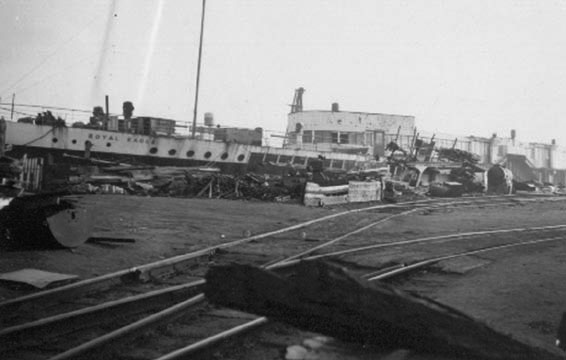
The Golden Eagle and the Royal Eagle were re-commissioned after the war but ran only until 1949 and 1950 respectively by which time the new Diesel fleet held sway. The Golden Eagle was scrapped in 1951 and, after a couple of years laid up in Whitewall Creek, almost opposite Kingswear Castle’s present berth on the Medway, the Royal Eagle (pictured above) was broken up by Wards at Grays in Essex in 1954.
The Royal Eagle was the last word in British excursion paddle steamer design with vastly enhanced undercover and saloon accommodation. Even the few paddlers built after her for service elsewhere were not quite in the same league. But she had a pitifully short career, sailing for only eight seasons before the Second World War and only five seasons after that, a total of just thirteen summers. This is nothing at all compared with Kingswear Castle’s eighty year career with thirty four years of her life having been spent on the Medway and with twenty one of them having have seen her offering passenger sailings on the Medway and Thames.
Kingswear Castle returned to service in 2023 after the first part of a major rebuild which is designed to set her up for the next 25 years running on the River Dart. The Paddle Steamer Kingswear Castle Trust is now fund raising for the second phase of the rebuild. You can read more about the rebuilds and how you can help if you can here.
John Megoran

